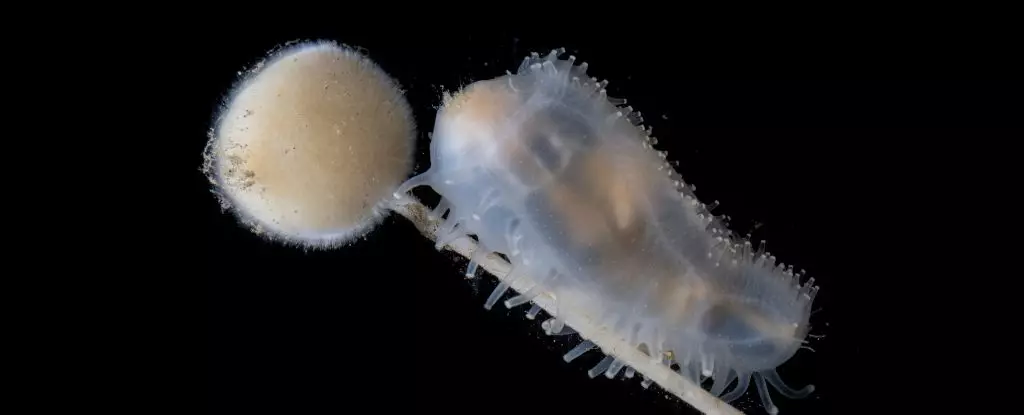In a world where the vastness of our oceans often remains an enigma, the recent deep-sea expedition led by the Schmidt Ocean Institute aboard the research vessel Falkor (too) has shattered preconceived notions about our marine ecosystems. For 35 days, an international consortium of scientists braved the treacherous waters of the South Sandwich Islands, diving into the profound abyss of the Southern Ocean near Antarctica. Rather than merely documenting life, this expedition challenged the narrative that we have already uncovered the secrets of our planet’s depths. The vibrant ecosystems that emerged from hydrothermal vents present not just a scientific opportunity but a compelling illustration of what is at stake amidst the rising threats of climate change and deep-sea mining.
The expedition did not come without peril, as the crew wrestled with nature’s formidable forces—severe underwater earthquakes, hurricane winds, mammoth waves, and the omnipresent risk of icebergs. Yet, from these tumultuous waters emerged astonishing discoveries that could redefine our understanding of marine life. Amongst the gripping highlights, the pristine vermillion coral gardens on Humpback Seamount showcased life at staggering depths, asserting the resilience of ecosystems often thought to be barren. Such images are wondrous, challenging the inherent pessimism surrounding marine degradation.
Beauty Beneath the Surface
The thrill of finding new species amidst the whirl of underwater life leaves little room for ambivalence. An exquisite nudibranch, artfully captured by blackwater photographer Jialing Cai, called attention to the delicate beauty that thrives in icy currents—an embodiment of life’s tenacity, even in the harshest conditions. However, awe-inspiring visuals are not without their shadows. Observing a grenadier fish burdened by parasitic copepods—deformities that lurk like monstrous pigtails—forces us to confront the unrelenting hostility of survival in the deep. Such images illustrate not just the fragility of existence in the depths but constitute a visceral reminder of the unforeseen consequences of human activities.
The discovery of previously unseen snailfish eggs anchoring to black corals targets our focus on marine biodiversity that remains shrouded in mystery. How is it that these treasures elude our gaze until now? The answer may lie in our limited explorations, revealing an unsettling truth: every discovery underscores the imperative to prioritize preservation over exploitation. Instead of racing toward unsustainable fishing or mining endeavors, should we not invest greater resources into safeguarding these untouched ecosystems?
The Call for Preservation
Marine biologist Michelle Taylor encapsulated the urgency of this mission perfectly when she stated that this endeavor was a glimpse into one of the ocean’s most biologically rich sanctuaries. The Ocean Census’s goal to document marine life before it inevitably succumbs to human interference serves as a clarion call for proactive conservation efforts. It is not mere rhetoric to champion the value of protecting our oceans; it is a moral imperative that transcends scientific inquiry. The vivid images and profound findings from the South Sandwich Islands extend far beyond academic interest; they should ignite a global movement that prioritizes ecological preservation.
While the success of this expedition inspires hope, it also raises crucial questions. If exhilarating discoveries continue to emerge from unexplored regions of the ocean, what do we sacrifice in our haste to exploit its resources? It becomes abundantly clear that the urgency to protect these ecosystems is not just an environmental concern; it’s an ethical obligation we owe to future generations. Our impact on these delicate marine systems may provoke irreversible changes that render the haunting beauty of these ecosystems mere relics in a history plagued by shortsightedness.
A Future Worth Fighting For
Yet, amidst the foreboding tension between discovery and destruction, there lies a flicker of hope. The voyage into the Pacific depths not only uncovers the splendor of marine habitats but symbolizes an awakening—a realization that the fate of our oceans rests firmly in our hands. The interaction of life amidst the hydrothermal vents tells a story not just of survival against the odds, but one of interconnectedness and diversity, reflective of our own communal existence.
As we marvel at the underwater marvels, the expedition’s revelations should propel us toward advocacy for robust marine policies and agreements that deter harmful practices. The ocean’s mysteries beckon us for exploration, but it is essential that we tread with respect, armed with the wisdom and responsibility that accompanies our growing awareness of what lies beneath. Only then can we ensure that the eternal dance of life in the ocean continues, unperturbed by our reckless ambitions. The age of discovery should also be the age of preservation; let us not forget that the ocean’s wonders are assets meant for stewardship rather than exploitation.


Leave a Reply